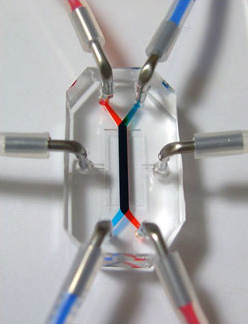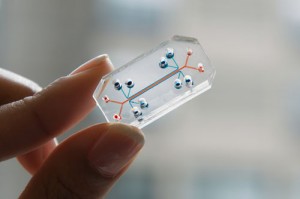Via Extreme Tech
-----
If a team of Harvard bioengineers has its way,
animal testing and experimentation could soon be replaced by
organ-on-a-chip technologies. Like SoCs (system-on-a-chip), which
shoehorn most of a digital computer into a single chip, an
organ-on-a-chip seeks to replicate the functions of a human organ on a
computer chip.
In Harvard’s case, its Wyss Institute has now created a living lung-on-a-chip, a heart-on-a-chip, and most recently a gut-on-a-chip.

We’re not talking about silicon chips simulating
the functions of various human organs, either. These organs-on-a-chip
contain real, living human cells. In the case of the gut-on-a-chip, a
single layer of human intestinal cells is coerced into growing on a
flexible, porous membrane, which is attached to the clear plastic walls
of the chip. By applying a vacuum pump, the membrane stretches and
recoils, just like a human gut going through the motions of peristalsis.
It is so close to the real thing that the gut-on-a-chip even supports
the growth of living microbes on its surface, like a real human
intestine.
In another example, the Wyss Institute has built a lung-on-a-chip,
which has human lung cells on the top, a membrane in the middle, and
blood capillary cells beneath. Air flows over the top, while real human
blood flows below. Again, a vacuum pump makes the lung-on-a-chip expand
and contract, like a human lung.
These chips are also quite
closely tied to the recent emergence of the lab-on-a-chip (LoC), which
combines microfluidics (exact control of tiny amounts of fluid) and
silicon technology to massively speed up the analysis of biological
systems, such as DNA. It is thanks to LoCs that we can sequence entire genomes in just a few hours — a task that previously took weeks or months.
These human organs-on-a-chip can be tested just
like a human subject — and the fact that they’re completely transparent
is obviously a rather large boon for observation, too. To test a drug,
the researchers simply add a solution of the compound to the chip, and
see how the intestinal (or heart or lung) cells react. In the case of
the lung-on-a-chip, the Wyss team is testing how the lung reacts to
possible toxins and pollutants. They can also see how fast drugs (or
foods) are absorbed, or test the effects of probiotics.
Perhaps
more importantly, these chips could help us better understand and treat
diseases. Many human diseases don’t have an animal analog. It’s very
hard to find a drug that combats Crohn’s disease when you can’t
effectively test out your drug on animals beforehand — a problem that
could be easily solved with the gut-on-a-chip. Likewise, it is very
common for drugs to pass animal testing, but then fail on humans.
Removing animal testing from the equation would save money and time, and
also alleviate any ethical concerns.
 Moving
forward, the Wyss Institute, with funding from DARPA, is currently
researching a spleen-on-a-chip. This won’t be used for pharmaceutical
purposes, though; instead, DARPA wants to create a “portable spleen”
that can be inserted into soldiers to help battle sepsis (an infection
of the blood).
Moving
forward, the Wyss Institute, with funding from DARPA, is currently
researching a spleen-on-a-chip. This won’t be used for pharmaceutical
purposes, though; instead, DARPA wants to create a “portable spleen”
that can be inserted into soldiers to help battle sepsis (an infection
of the blood).
And therein lies the crux: If you can create a chip
that perfectly mimics the spleen or liver or intestine, then what’s to
stop you from inserting those chips into humans and replacing or
augmenting your current organs? Instead of getting your breasts
enlarged, you might one day have your liver enlarged, to better deal
with your alcoholism. Or how we connect all the organ chips together and
create a complete human-on-a-chip?


